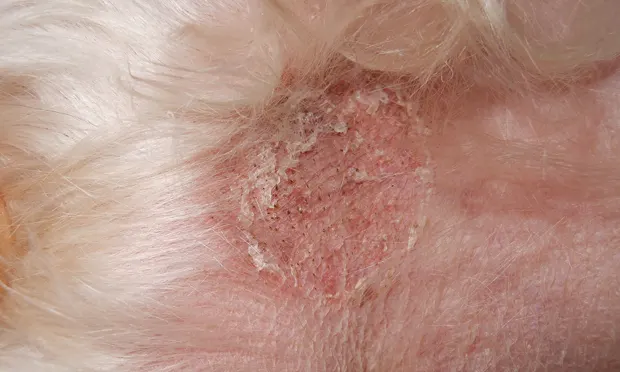HEALTH MATTERS Ringworm (dermatophytosis)
by Melanie Thomas
Ringworm is a fungal infection caused by a micro-organism called dermatophytosis. The condition causes crusty lesions on the skin which are often round, hence the name ‘ringworm’, but there is no worm involved. Ringworm is infectious if not treated as the spores spread easily.
Ringworm affects dogs, cats, guinea pigs, horses and even people. Even though a healthy dog should recover from Ringworm in a few weeks, you should seek advice from your vet asap to avoid the condition spreading. When a dog recovers from Ringworm they are usually resistant to the infection for a while. The condition can mimic other skin conditions such as mite or bacterial infections.
Symptoms
Your dog could be infected with Ringworm without showing symptoms for a few weeks until the condition takes hold. The dermatophytosis micro-organisms feed on hair, nails and dead skin. Affected areas look like reddish rings of dry scaly itchy skin with recovering areas in the middle. The infection infects one hair shaft, then spreads to those around it.
As Ringworm starts to develop it leads to raised, crusty bumps that you can feel as you stroke your dog and you may see hair loss progressing outwards. Your dog could end up with large bald areas as the hair follicles break off. You could see your dog scratching and licking at its skin. Sometimes dermatophytosis affects the pads and nails causing them to grow deformed, become brittle and break.
Treatment
You must visit your vet if your dog develops any kind of skin condition. To diagnose ringworm, your vet will examine your dog and could take a sample of hair to examine under the microscope. Samples can also be placed in a growth medium and tested for fungal growth, or sent away to a laboratory. Nail clippings can also be tested for fungal culture.
Topical treatments are used to reduce shedding, kill spores and prevent new areas developing. Anti-fungal shampoos are also used, possibly twice a week. Oral medications may be used as they attack the spores within the hair follicles. Bacterial infections can occur along side a ringworm infection, so anti-biotics could be prescribed as part of the treatment.

